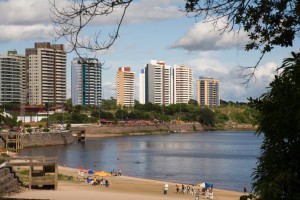Set out on a comprehensive adventure filled with sights and experiences unique to Peru, including up-close views of its incredibly diverse wildlife and an unforgettable stay in one of the most remote lodges in South America. Journey by train through the awe-inspiring Andes to ancient Lake Titicaca and explore the legendary “White City” of Arequipa as well as the incomparable Incan citadel of Machu Picchu.
Amazon Jungle (Peru)
Amazon Jungle (Peru)
The Peruvian Amazon borders Ecuador, Brazil, and Bolivia. The area is rich in biodiversity and has the second-largest portion of the Amazon.
|
Destination Guide
|
|
Saracocha
|
|
Lake Titicaca (Peruvian Coast)
Lake Titicaca (Peruvian Coast)
Titicaca, the world's highest navigable lake, is a world unto itself—a definite must-see. It's located 560 mi/900 km southeast of Lima, on the Peru/Bolivia border, at an altitude of 12,500 ft/3,812 m. One way to see Titicaca is on the 12-hour train ride from Cuzco to Puno through the Andes, a trip that reaches an elevation of more than 14,000 ft/4,265 m as you pass by farms, people's backyards, waterfalls and bleak but wondrous scenery—clear blue sky, deep blue water and dry, barren landscape. This is an expensive tourist train and runs three or four times a week; the local train, which was notorious for thievery, no longer operates. Tourist buses also cover this route, stopping at major sights en route. They are faster and have English-speaking guides. Peruvians and tourists on a time limit take normal buses between Cusco and Puno, usually a six-hour trip. Don't neglect the attractions on the Bolivian side of the lake. Stop overnight in Puno, an uninspiring town near the border that's one of the best places in Peru to buy Andean handicrafts—alpaca sweaters, rugs, ponchos and tapestries. (The town is also known for its colorful fiestas and folk dances.) Then continue by bus or car to Copacabana, just across the border, for Bolivian customs formalities and to tour the cathedral or take a day trip to the Isla del Sol and Isla de la Luna. With its small-village atmosphere and charm, this town is a nice overnight stay from which you can see more of the lake. From Puno, tours or public transport are available to Taquile Island (small Inca ruins and very nice woven goods), Sillustani on Lake Umayo (to see chullpas, the funerary towers of the ancient Colla people) and the Floating Islands (actually enormous floating reed mats that support the Uros people's villages of reed huts—you can buy reed souvenirs there).
|
Destination Guide
|
Arequipa
Arequipa
Sparkling in the sun, Arequipa is called the White City because of the sillar, a white volcanic stone that makes up its buildings, modern ones as well as Spanish colonial. Peru's second-largest city sits surrounded by towering mountains—including the 19,000-ft/5,800-m volcano El Misti. The city itself is the home of the monastery of La Recoleta (with a museum and library) and several interesting churches, but its highlight is the Santa Catalina Convent. Built in the late 16th century (but closed to the public until 1970), it was a self-contained community, a place where nuns could worship and live without leaving the convent. Walk through the well-preserved structure, soak up the peaceful atmosphere and discover the tiny, secluded plazas and lovely courtyards within. From Arequipa, take a guided tour of Colca Canyon, one of the deepest canyons in the world (10,500 ft/3,191 m deep). (Day trips are possible, but they require many hours in a bus and are not recommended; two- or three-day trips are preferable.) Several local agencies arrange two-day trips with pleasant overnights in rural hotels. A journey to the canyon offers a view of extensive pre-Incan and Incan agricultural terracing, some of which is still farmed today, as well as a chance to see Andean condors at Cruz del Condor, a lookout point. Adventurous travelers can follow in the footsteps of the chasqui, the Incan foot messengers, and trek the canyon. The Cotahuasi Canyon is more remote than the Colca, but it is the deepest in the world, with stretches as low as 10,857 ft/3,300 m. It is located 125 mi/200 km northwest of Arequipa. Or visit the Reserva Nacional de Salinas y Aguada Blanca, a nature reserve with stunning lakes and salt flats, located high in the surrounding mountains. The area is about 465 mi/750 km southeast of Lima by air. By road, the distances are closer to 625 mi/1,000 km.
|
Destination Guide
|
Cuzco
Cuzco
The Cuzco (Cusco) region of Peru combines Inca legacy with Spanish colonial architecture in an atmosphere at once provincial and sublime. The chaotic marketplaces where campesinos barter grain or potatoes for multi-colored fabric belie the mute spirituality of the Lost Cities, where Inca stonework conveys order and balance. Such diversity enhances this inspiring nine-day adventure. The blue sky radiates with an intensity achieved only at high altitudes (the city of Cuzco lies 11,150 feet above sea level), while the landscape offers its unique pattern of exacting agricultural grids and tangled jungle masses.
|
Destination Guide
|
Puerto Maldonado
Puerto Maldonado
Gold panning on the Tampobamba and Madre de Dios rivers, and the latex boom at the end of the past century, determined the foundation of the city of Puerto Maldonado., Today, Madre de Dios, the old Inca Antisuyo, is still what It has been -for centuries- for all adventure lovers: a virgin and frontier land full of mysteries.
Near Puerto Maldonado, there are several attractions such as the Sandoval and Valencia lakes, next to the Bolivian border (by river, 4 hours from the city), These wonderful places give the tourist the opportunity to fish, be close to nature, and be in contact with native communities.
|
Destination Guide
|
Lima
Lima
Lima, "the City of the Kings," became the effective capital of the Viceroyalty of Peru, established 1560. Today, a visit to Lima may serve as a unique Peruvian experience that offers a glimpse into the Andean world, Spanish tradition and the country's modern aspect. Visit handsome old buildings and baroque churches that testify to the city's religious background and the Plaza de Armas, shared by the realms of the Catholic church, municipality and national government. The pre-Inca ruins of Pachacamac lie a short distance south of the city. Once a ceremonial site, Pachacamac has been the most important religious center of the Andean world since before the age of Christ. Stop and admire The Temple of the Sun and the Moon, Lima's outstanding museums, and Machu Picchu - a "Jewel in the Mist."
|
Destination Guide
|






